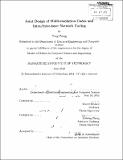Joint design of multi-resolution codes and intra / inter- layer network coding
Author(s)
Wang, Tong, Ph. D. Massachusetts Institute of Technology
DownloadFull printable version (3.846Mb)
Other Contributors
Massachusetts Institute of Technology. Dept. of Electrical Engineering and Computer Science.
Advisor
Muriel Médard and Lizhong Zheng.
Terms of use
Metadata
Show full item recordAbstract
In this thesis, we study the joint design of multi-resolution (MR) coding and network coding. The three step coding process consists of MR source coding, layer coding and multi-stream coding. The source coding considers the allocation of codeword length to the two layers and use base layer percentage as the parameter. In the network coding model, we present two coding schemes, intra-layer and inter-layer network coding and use two elements as design parameters: 1) Redundancy at different layer. 2) Whether to code within a layer or across layers. Two metrics, average distortion and total redundancy, are used to characterize quality and efficiency. We define the notion of redundancy plane and provide coding strategies based on this plane. We draw two important conclusions: 1) Inter-layer coding always achieves at least the same performance as intra-layer coding. The mixing of layers never hurts from this perspective. 2) The optimal performance for inter-layer coding is independent of the base layer percentage. Besides the two observations, we also point out that in some region, inter-layer coding can be replaced by changing the parameters without harming the quality or efficiency. Our coding strategies give guidelines for choosing between the two coding schemes in different situations and how to replace inter-layer coding with intra-layer coding while achieving the same performance in terms of quality and efficiency.
Description
Thesis (S.M.)--Massachusetts Institute of Technology, Dept. of Electrical Engineering and Computer Science, 2012. Cataloged from PDF version of thesis. Includes bibliographical references (p. 73-74).
Date issued
2012Department
Massachusetts Institute of Technology. Department of Electrical Engineering and Computer SciencePublisher
Massachusetts Institute of Technology
Keywords
Electrical Engineering and Computer Science.